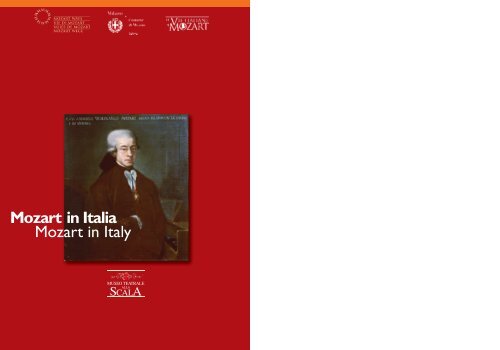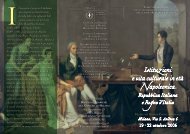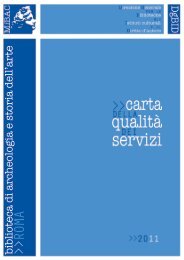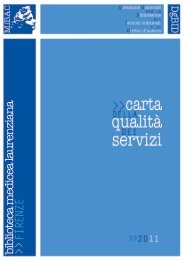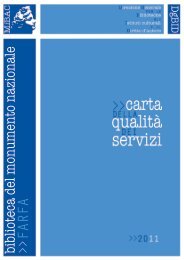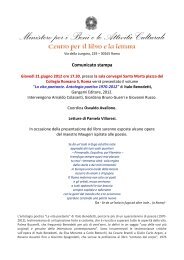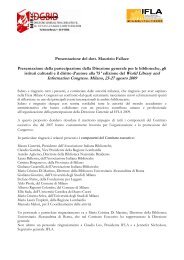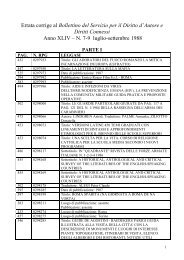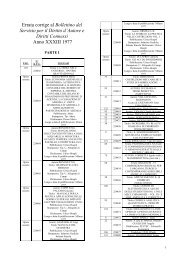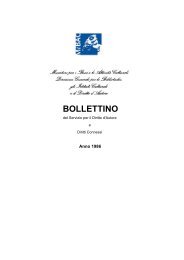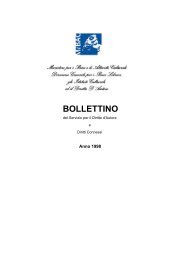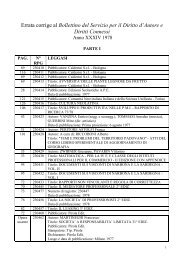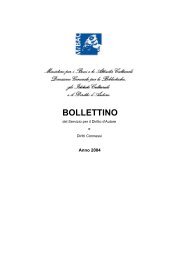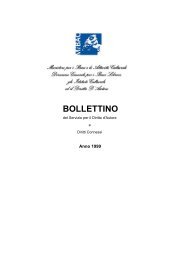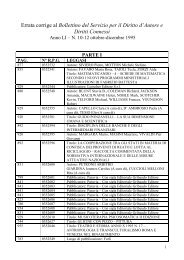Opuscolo (Pdf) - Direzione Generale per i Beni Librari e gli Istituti ...
Opuscolo (Pdf) - Direzione Generale per i Beni Librari e gli Istituti ...
Opuscolo (Pdf) - Direzione Generale per i Beni Librari e gli Istituti ...
Create successful ePaper yourself
Turn your PDF publications into a flip-book with our unique Google optimized e-Paper software.
Mozart in Italia<br />
Mozart in Italy
In co<strong>per</strong>tina<br />
Ritratto di Wolfgang Amadeus Mozart<br />
(1756-1791) Vienna, 1777 (?)<br />
olio su tela, inv. B 39131 / B 11812<br />
Si ringrazia il Museo internazionale<br />
e biblioteca della Musica di Bologna<br />
<strong>per</strong> la cortese concessione<br />
di riproduzione del dipinto.<br />
Mozart in Italia<br />
L’enigma di una collezione
Per la quarta volta, Mozart ritorna a Milano, con un ritratto finora inedito,<br />
risco<strong>per</strong>to da poco in California, ed esposto al pubblico in prima mondiale<br />
al Museo Teatrale alla Scala, ambiente mozartiano come pochi altri.<br />
Ringrazio i collezionisti <strong>per</strong> l’opportunità di presentare il dipinto all’attenzione<br />
de<strong>gli</strong> appassionati; il Museo Teatrale alla Scala, il Teatro alla Scala e il Comune<br />
di Milano <strong>per</strong> la collaborazione prestata (anche) in questa occasione.<br />
Col ritorno simbolico di Mozart a Milano, si conclude il <strong>per</strong>corso del Comitato<br />
Nazionale “Le vie Italiane di Mozart”, insediato <strong>per</strong> ricordare il 250° anniversario<br />
della nascita del compositore nel 2006 e caratterizzato dall’innovativo disegno<br />
di associare in una rete le decine e decine di città mozartiane italiane e delle<br />
istituzioni culturali in esse presenti.<br />
Alla fine di questa pubblicazione è riportata, a mo’ di rendiconto e<br />
documentazione, una panoramica delle attività svolte in questo <strong>per</strong>iodo.<br />
Esse sono state pensate all’interno di una strategia volta a favorire, rispetto a<br />
iniziative estemporanee e occasionali, interventi di riconosciuto valore scientifico<br />
e duratura vitalità. L’ambiente culturale e musicale italiano deve sentirsi fiero<br />
di avere dato vita, in questa circostanza, a progetti, contributi e pubblicazioni che<br />
resteranno un punto fermo ne<strong>gli</strong> studi mozartiani, anche a livello internazionale.<br />
E proprio con questa iniziativa avremo modo di ribadirlo, presentando a Milano,<br />
in una sede emblematica quale il Palazzo di città, <strong>gli</strong> ultimi interventi.<br />
Mi complimento ancora con tutti i partecipanti al Comitato Nazionale “Le vie<br />
italiane di Mozart” <strong>per</strong> la vitalità e la ricchezza progettuale dimostrate in questa<br />
occasione; e ringrazio calorosamente e affettuosamente i componenti della<br />
Giunta esecutiva, e i rappresentanti del Ministero <strong>per</strong> i <strong>Beni</strong> e le Attività Culturali<br />
che, insieme, hanno reso possibile con il loro entusiasmo e con la loro<br />
generosità l’attività e i risultati del Comitato stesso. Altrettanto preziose sono<br />
risultate la collaborazione e la costante vicinanza – ribadita ancora in questa<br />
occasione – dall’associazione “European Mozart Ways”, il cui straordinario<br />
successo prese le mosse grazie anche all’impegno dell’amministrazione civica<br />
di Milano.<br />
Abbiamo così contribuito, in tanti, a riaffermare Mozart come espressione<br />
– anche – della cultura italiana: ribadendo così la funzione unificatrice della<br />
cultura e della musica; e interpretando il lascito estremo di una figura<br />
leggendaria che coi suoi viaggi tracciò quella rete che ha contribuito a forgiare<br />
una comune identità europea, capace di su<strong>per</strong>are barriere di lingue e tradizioni<br />
e di farci sentire partecipi di un comune destino.<br />
Salvatore Carrubba<br />
Presidente del Comitato nazionale “Le vie italiane di Mozart”<br />
Mozart in Italy, Mozart and Italy: these closely related topics at once embody<br />
both the conclusion of our first arch, presenting the celebrations around the<br />
anniversary of 2006 under the auspices of the National Committee “Le vie<br />
italiane di Mozart”, and the beginning of the next: within the Culture 2007-13<br />
program of the European Union “Mozart and Italy” is dedicated to exploring<br />
several “Modern Reflections of Intercultural Dialogue in the 18 th Century” in the<br />
context of a partnership between Salzburg, Augsburg, Milan, London as well as<br />
Bologna,Vienna and Royaumont.<br />
Under these circumstances, the apparently casual juxtaposition of two disparate<br />
topics – the letters from Italy and the Hagenauer collection – engenders a<br />
stimulating counterpoint of themes in the exhibition very promptly conceived<br />
and organized at Museo Teatrale alla Scala thanks to the readiness of lenders<br />
and co-hosts. One of our closest allies, the International Mozarteum Foundation,<br />
even consented to the extremely rare and precious exception of showing<br />
original letters from Mozart’s Italian journeys, thereby providing the most<br />
inspiring wishes to the official start of the project “In Mozart’s Words”.<br />
This online multilingual publication of letters, with searchable database<br />
of places, names and works, inaugurates a most innovative and open approach<br />
to one of the foremost sources of musical documentation in any epoch, which<br />
will offer a unique treasury of information (and enjoyment) for scholars and<br />
music lovers alike.<br />
The Hagenauer collection – exhibited in a sizeable selection here as a world<br />
premiere – makes no mystery of its Italian connections, originating as it does<br />
from the Italian branch of this Salzburg family so closely and significantly tied to<br />
the Mozarts: combined with the debate on authenticity of new “Mozart”<br />
portraits – there will be two shown here – it is a direct testimony of the fact<br />
that discoveries, as well as the scholarly research interwoven with them, are not<br />
a thing of the past, but prominently animate the present with curiosity and<br />
thought-provoking dialogues.<br />
The European Mozart Ways once again amplify the rich implications of such<br />
productive networking, and enthusiastically pursue their commitment to take<br />
the relay of “Le vie italiane” alongside their multiple itineraries in the 10<br />
countries visited by Mozart during his travels (over a third of his short and<br />
unparalleled life), which represent the only “Major Cultural Route” of the<br />
Council of Europe dedicated to a musician.<br />
All this confirms that although if Mozart left Italy barely after his 17 th birthday<br />
(surely with some regrets), since then Italy in many ways never left him, his<br />
interests, his works, his pleasures: the Italian events and their ongoing echoes<br />
bear witness to this continuity with ever renewed delight.<br />
Maria Majno<br />
President of the European Mozart Ways<br />
2 3
Ritratto di Mozart adolescente<br />
Miniatura su avorio di Martin<br />
Knoller, il più eminente pittore<br />
austriaco lungamente vissuto a<br />
Milano al tempo di Maria Teresa,<br />
presumibilmente dipinta verso il<br />
1773 e appartenuta alla sorella<br />
di Mozart Nannerl.<br />
Mozarts Geburtshaus, Salisburgo<br />
© Internationale Stiftung Mozarteum<br />
Collaudo di un genio<br />
Raffaele Mellace<br />
Sopra di noi c’è un violinista, sotto di noi ce n’è un altro, accanto<br />
un maestro di canto che dà lezione, nell’ultima stanza di fronte<br />
alla nostra c’è un oboista. È divertente <strong>per</strong> comporre!<br />
Fa venire molte idee.<br />
(W. A. Mozart a sua sorella, post-scriptum a una lettera del padre<br />
Leopold da Milano, 24 agosto 1771)<br />
Dal dicembre 1769 al marzo 1773 (ossia fra i tredici e i diciassette anni) Mozart<br />
adolescente viene immerso dal padre Leopold in una delle es<strong>per</strong>ienze formative<br />
più intense e cospicue disponibili al compositore in erba di quel secolo e non<br />
solo: tre viaggi quasi consecutivi in quella che i contemporanei consideravano la<br />
sorgente della scienza e dell’arte musicali, l’Italia. Nel tourbillon di incontri ed<br />
avventure del primo viaggio, dal Brennero a Napoli e ritorno, così come nei più<br />
circoscritti itinerari milanesi del secondo e del terzo,Wolfgang entra a contatto<br />
diretto con una produzione musicale che <strong>per</strong> alcuni colleghi (si pensi, qualche<br />
generazione prima, a Bach, o, in tempi più prossimi, a Haydn) era rimasta<br />
relegata alla conoscenza mediata dalle biblioteche principesche in patria<br />
o dall’incontro coi musicisti della diaspora italiana in Europa. Un’es<strong>per</strong>ienza resa<br />
ulteriormente formativa dall’età, giovanissima, dell’apprendista compositore, che<br />
non aveva dovuto attendere i vent’anni <strong>per</strong> oltrepassare le Alpi, com’era invece<br />
accaduto a Händel, Hasse, Gluck, Johann Christian Bach. A tacere del vantaggio<br />
offerto della leggendaria, prodigiosa memoria del giovane talento, di cui la<br />
trascrizione del Miserere di Gregorio Allegri <strong>per</strong> doppio coro a nove voci, a<br />
seguito d’un singolo ascolto alla Cappella Sistina, costituisce soltanto l’aneddotica<br />
punta dell’iceberg. Risulta dunque facile intuire quanto un apprendistato tanto<br />
formidabile abbia influito sulla formazione di Mozart adolescente, contribuendo<br />
ad allargarne <strong>gli</strong> orizzonti musicali e culturali, orientarne il gusto, <strong>per</strong>fezionarne<br />
la tecnica, arricchirne la familiarità con meccanismi produttivi, ampliarne<br />
incomparabilmente la conoscenza del goldoniano gran libro del mondo.<br />
Impossibile disgiungere la principale ragione, di natura promozionale,<br />
dell’avventura italiana (l’intento di «prodursi in qualche maniera, e farsi<br />
conoscere», esplicitato dalla lettera di raccomandazione fornita ai Mozart da<br />
Hasse il 4 ottobre 1769) dal carattere formativo di quei viaggi. Significativi ma<br />
isolati in alcune tappe <strong>gli</strong> incontri con musicisti di prima sfera (il Farinelli e padre<br />
Martini a Bologna, Pietro Nardini a Firenze, ma quasi nessuno a Venezia e a<br />
Roma), diventano un vero assedio a Torino, a Milano e a Napoli, dove padre e<br />
fi<strong>gli</strong>o vengono omaggiati rispettivamente da Gaetano Pugnani, Quirino Gasparini<br />
e dai fratelli Besozzi; Giovanni Battista Sammartini, Niccolò Piccinni, Giovanni<br />
Battista Lampugnani, Giovanni Andrea Fioroni, Melchiorre Chiesa, Carlo Monza;<br />
Giovanni Paisiello, Niccolò Jommelli, Pasquale Cafaro, Gennaro Manna. Incontri<br />
cordiali, nati dall’incrocio tra la sete di conoscenza del forestiero e la benevola<br />
curiosità dei colleghi più anziani («Circa 15 o 18 anni or sono, quando<br />
5
Lettera da Milano, 20 ottobre<br />
1770 (BD 214, facsimile)<br />
Leopold descrive alla mo<strong>gli</strong>e<br />
il successo di Wolfgang<br />
nell’esame di ammissione<br />
all’Accademia Filarmonica di<br />
Bologna;Wolfgang nel PS si<br />
scusa di non poter scrivere<br />
molto <strong>per</strong>ché <strong>gli</strong> fanno male le<br />
dita dal tanto lavoro sull’o<strong>per</strong>a<br />
Mitridate, re di Ponto. Saluta<br />
tutti <strong>gli</strong> amici e compiange la<br />
morte della sua amica Martha,<br />
fi<strong>gli</strong>a del loro padrone di casa<br />
Johann Lorenz Hagenauer.<br />
Lampugnani scriveva così tanto in Inghilterra e Melchior Chiesa in Italia […],<br />
se qualcuno mi avesse detto: questi uomini serviranno la musica di tuo fi<strong>gli</strong>o<br />
[…], io l’avrei preso <strong>per</strong> matto e l’avrei spedito dritto filato al manicomio»,<br />
gongola Leopold scrivendo alla mo<strong>gli</strong>e il 5 gennaio 1771 da Milano), contorno di<br />
un’attività concertistica pubblica e privata, tra accademie e ricevimenti nobiliari,<br />
in cui Mozart conosce e «si fa conoscere». L’impressione dell’acco<strong>gli</strong>enza<br />
in queste città e della vivacità dei rispettivi ambienti musicali – creativamente<br />
caotico, come si è visto, è l’alloggio milanese che acco<strong>gli</strong>e i Mozart nell’agosto<br />
1771, ma altrettanto chiassosa, secondo le testimonianze coeve, era l’atmosfera<br />
dei conservatori napoletani – è ancora viva un decennio dopo nella memoria di<br />
Leopold, che dissuadendo il fi<strong>gli</strong>o dal tentare nuovamente la carta italiana<br />
rievoca la Penisola come un luogo «dove soltanto a Napoli vivono certamente<br />
300 maestri» (lettera del 23 febbraio 1778).<br />
Sicuramente il guadagno fondamentale dei viaggi italiani, e di gran lunga il più<br />
duraturo e continuativo, consiste nell’assorbimento integrale del giovane talento<br />
nel sistema dell’o<strong>per</strong>a italiana, con le sue peculiarità artistiche e il variopinto<br />
circo dei suoi artefici. Nei teatri della Penisola, dai più illustri ai più defilati<br />
(il San Carlo di Napoli e il Regio Ducale di Milano, ma anche le sale di Mantova<br />
e Verona), Mozart vede o<strong>per</strong>e serie e buffe di Giovanni Battista Borghi,<br />
Giuseppe Gazzaniga, Pietro Gu<strong>gli</strong>elmi, Johann Adolf Hasse, Giovanni Paisiello,<br />
Niccolò Piccinni, ma anche dell’oscuro Antonio Boroni, dalle Clemenze di Tito alle<br />
Contadine furlane, dai Siroe alle Spose fedeli, in uno stillicidio di rappresentazioni<br />
che costellano come un rosario l’itinerario dei diversi viaggi. Nei <strong>per</strong>iodi più<br />
residenziali assiste a diverse repliche, compensa, se impossibilitato ad andare<br />
a vedere l’o<strong>per</strong>a, con l’«ascoltarla e vederla nella mia mente anche a casa»<br />
Lettera da Milano, 1° dicembre<br />
1770 (BD 221, facsimile)<br />
Leopold spiega alla mo<strong>gli</strong>e che<br />
Wolfgang ha ancora molto da<br />
fare <strong>per</strong> il Mitridate, <strong>per</strong>ché<br />
ancora non è arrivato il castrato<br />
Sartorini <strong>per</strong> la parte di Sifare.<br />
Wolfgang si associa a questa<br />
preoccupazione e s<strong>per</strong>a<br />
“che andrà tutto bene”.<br />
(post-scriptum a una lettera di Leopold da Milano del 2 novembre 1771), ritarda<br />
la partenza <strong>per</strong> non <strong>per</strong>dersi uno spettacolo (il Sismano nel Mogol di Paisiello).<br />
Sviluppa così un’acuta consapevolezza stilistica, prende confidenza con le diverse<br />
scuole di canto e tipologie di interpreti, assimila consuetudini e trucchi del<br />
mestiere. Giudica l’Armida abbandonata di Jommelli «bella, ma decisamente<br />
troppo posata e vecchio stile <strong>per</strong> il theatro» (post-scriptum a una lettera del<br />
padre da Napoli, 5 giugno 1770); nella stessa circostanza elogia le interpretazioni<br />
del soprano Anna De Amicis e del castrato Giuseppe Aprile; da Verona, dove<br />
vede al Filarmonico il Ruggiero di Pietro Gu<strong>gli</strong>elmi, offre alla sorella una disamina<br />
completa della prestazione dell’intero cast (lettera del 7 gennaio 1770); avrà poi<br />
modo di s<strong>per</strong>imentare <strong>per</strong>sonalmente le doti canore di altri interpreti di va<strong>gli</strong>a,<br />
da Antonia Bernasconi a Giovanni Manzuoli, da Antonia Maria Girelli Aguilar<br />
a Giuseppe Tibaldi, da Venanzio Rauzzini alla stessa De Amicis, cimentandosi con<br />
la confezione di parti impegnative rita<strong>gli</strong>ate sulle loro corde.<br />
È infatti in Italia, a Milano, che avviene il vero battesimo del Mozart o<strong>per</strong>ista,<br />
su un altro piano rispetto alle prove più giovanili. Un battesimo propiziato da<br />
una sorta d’investitura, il 7 febbraio 1770, al milanese Palazzo Melzi, dove il conte<br />
Carl Joseph von Firmian, ministro plenipotenziario asburgico nel Ducato di<br />
Milano, fa dono al compositore, da pochi giorni quattordicenne, della preziosa<br />
edizione Reale di Torino delle o<strong>per</strong>e di Metastasio – il letterato che, con buona<br />
pace di Da Ponte, rappresenterà il più fedele compagno di Mozart da un capo<br />
all’altro della sua vita –, preludio, dopo un concerto audizione di arie e scene da<br />
concerto, della scrittura <strong>per</strong> il Mitridate, re di Ponto. Ed è sempre a Milano che<br />
Mozart sarà coinvolto <strong>per</strong> la prima volta nella realizzazione d’una produzione<br />
o<strong>per</strong>istica in vista d’un progetto dinastico di primo piano, con la commissione<br />
della festa teatrale Ascanio in Alba <strong>per</strong> le nozze arciducali del 1771.<br />
6 7
Lettera da Milano, 23 gennaio<br />
1773 (BD 281, originale poi<br />
facsimile)<br />
Leopold Mozart rinvia il ritorno<br />
a Salisburgo sotto il pretesto di<br />
forti reumatismi, <strong>per</strong>ché tuttora<br />
s<strong>per</strong>a in un intervento del<br />
Granduca Leopoldo di Toscana<br />
<strong>per</strong> assicurare un posto al fi<strong>gli</strong>o.<br />
Il PS di Wolfgang alla sorella è<br />
interamente in italiano<br />
« signor e signora d’Arte e sigr.r germani sig Mislivecek sig.ra de Amicis m’hanno imposti di scriver<br />
e significarti i di lori complimenti e rispetti. vi prego di dire al sig. giovani. hagenauer da parte mia,<br />
che non dubiti, che andrò à veder sicuramente in quella bottega delle armi, se ci sono quei nomi che lui<br />
desidera, e che senza dubbio doppo averli trovati le porterò meco à Salisburgo. mi dispiace che<br />
il sig. leitgeb è partito tanto tardi da salisburgo che non troverà più in scena la mia o<strong>per</strong>a, e forse non ci<br />
troverà nemeno, se non in viaggio. hieri sera era la prima prova coi stromenti della seconda o<strong>per</strong>a ma hò<br />
sentito solamente il primo Atto, <strong>per</strong>chè al secondo mene andiedi eßendo già tardi. in quest’o<strong>per</strong>a sarànno<br />
sopra il balco 24 cavalli e un mondo di gente, che sarà miracolo se non succede qualche disgrazia.<br />
la Musica mi piace, se piace al Puplico non sò, <strong>per</strong>chè alle prime prove non è lecito l’andarci che alle<br />
<strong>per</strong>sone che sono dell Teatro. io s<strong>per</strong>o che domani il mio padre potrà uscir di casa. stàsera fà cativißimo<br />
Tempo. la sig.ra teiber è adeßo a bologna e il carnevale venturo reciterà à torino, e l’anno sußiquente poi<br />
và à cantar à Napoli. i miei rispetti à tutti i miei amici e amiche. bacciate da parte mia alla mia madre<br />
le mani. non sò niente più. addio <strong>per</strong>donate la mia cativa scritura, la penna non vale un corno »
Lettera da Milano, 5 dicembre<br />
1772 (BD 269, facsimile)<br />
Nel racconto di Leopold, le<br />
difficoltà <strong>per</strong> la preparazione<br />
della prima di Lucio Silla.<br />
La prima donna è appena<br />
arrivata, ma ancora si è alla<br />
ricerca del protagonista.<br />
Wolfgang spiega alla sorella<br />
che <strong>gli</strong> restano ancora da<br />
comporre 14 numeri, fra i quali<br />
un terzetto e un duetto molto<br />
più complessi, e <strong>per</strong>tanto si<br />
scusa di non poter aggiungere<br />
molto, correndo il <strong>per</strong>icolo di<br />
scrivere “un’intera Aria” invece<br />
delle parole.<br />
Nelle soste e <strong>per</strong>sino durante i viaggi Mozart aveva intanto provveduto a<br />
praticare con assiduità anche l’idioma della musica strumentale, non<br />
specificamente italiano quanto l’o<strong>per</strong>a eppure ugualmente notevole nella<br />
fenomenologia della vita musicale coeva. La Penisola si mostra infatti al giovane<br />
talento come un grandioso laboratorio strumentale, in cui si sviluppano generi<br />
di punta come la sinfonia, fioriscono scuole violinistiche di antica o recente<br />
costituzione, si esibiscono, nei teatri come nelle accademie, orchestre di tutto<br />
rispetto. A Milano viene in contatto con la lezione di Sammartini e de<strong>gli</strong> altri<br />
sinfonisti milanesi, molto attivi ed eseguiti anche in concerti all’a<strong>per</strong>to, non<br />
restando insensibile al sonatismo preclassico del loro linguaggio, così come si<br />
dimostra a<strong>per</strong>to al magistero profuso dai napoletani nelle loro sinfonie avanti<br />
l’o<strong>per</strong>a; in una locanda di Lodi inaugura la produzione di quartetti d’archi<br />
(col K. 80 / 73f, un lavoro che non dimenticherà presto) cui seguirà la serie dei<br />
cosiddetti Quartetti “milanesi” K. 155-160); nel Divertimento K. 113, ugualmente<br />
milanese, recluta <strong>per</strong> la prima volta i clarinetti, scoprendo un timbro votato a un<br />
destino quanto mai mozartiano; tra Milano Bologna e Roma compone diverse<br />
sinfonie, inclusa quella K. 74 che ospita nel finale un’anticipazione dello stile “alla<br />
turca”; s’interessa alla musica da danza, in particolare alla contradanse e al<br />
minuetto alla tedesca, che vorrebbe introdurre in Italia, «giacché i loro minuetti<br />
durano quasi quanto un’intera sinfonia» (post-scriptum a una lettera del padre<br />
da Bologna del 22 settembre 1770).<br />
Considerevole anche il profitto che Wolfgang trae dalla frequentazione della<br />
musica sacra, grazie a una serie di es<strong>per</strong>ienze che si segnalano, oltre che <strong>per</strong><br />
i valori musicali in gioco, anche <strong>per</strong> una ritualità memorabile e la monumentalità<br />
dei luoghi (San Pietro a Roma, la Basilica del Santo a Padova) che dovettero<br />
incidere nella memoria del viaggiatore adolescente: lo stile antico e il moderno,<br />
Programma del concerto tenuto<br />
dal “Giovinetto signor Amadeus<br />
Motzzard” all’Accademia<br />
Filarmonica di Mantova<br />
il 16 gennaio 1770<br />
la polifonia osservata del citato<br />
Miserere di Allegri eseguito nella<br />
cornice solenne dei riti della<br />
Settimana Santa nella Cappella<br />
Sistina l’11 aprile 1770, la cerimonia<br />
di vestizione monacale di Capua col<br />
suo corredo sonoro moderno di<br />
sinfonie e Salve Regina il 13 maggio<br />
successivo, la «bellissima» musica<br />
sacra di Giuseppe De Majo<br />
ascoltata a Napoli il 26 di quello<br />
stesso mese, i vespri e la messa<br />
appositamente composti dai<br />
membri dell’Accademia Filarmonica<br />
di Bologna il 30 agosto seguente<br />
nella Chiesa bolognese di San Giovanni al Monte. Che Mozart ben conoscesse<br />
e apprezzasse la solennità delle celebrazioni della Penisola ben si evince dal<br />
rammarico con cui scrive a padre Martini, ormai da Salisburgo, sulle convenzioni<br />
vigenti in riva al Salzach: «La nostra musica liturgica è molto diversa da quella<br />
italiana» (lettera del 4 settembre 1776). Al banco di prova della musica sacra,<br />
e allo stile antico, era legata <strong>per</strong>altro anche l’ammissione alla prestigiosa<br />
Accademia Filarmonica procurata<strong>gli</strong> dall’antifona Quaerite primum regnum Dei<br />
K. 86 / 73v, primizia d’una piccola produzione in polifonia osservata o moderno<br />
stile parao<strong>per</strong>istico, come l’oratorio metastasiano La Betulia liberata o il<br />
mottetto Exsultate, jubilate scritto <strong>per</strong> il sopranista Venanzio Rauzzini, primo<br />
uomo del Lucio Silla. Se nell’impiego chiesastico dello stile moderno Wolfgang<br />
non necessitava certo di maestri stante il suo curriculum o<strong>per</strong>istico,<br />
l’apprezzamento dello stylus antiquus si deve all’incontro con la figura carismatica<br />
di padre Martini, la cui cara e buona immagine paterna dovette lasciare un segno<br />
non passeggero nella sensibilità dell’allora quattordicenne, che con queste parole<br />
commoventi chiuderà, anni dopo, una lettera al religioso: «Non cesso<br />
d’affliggermi nel vedermi lontano dalla Persona del Mondo che maggiormente<br />
amo, venero e stimo» (lettera del 4 settembre 1776).<br />
Discendendo <strong>per</strong> la Penisola, Leopold Mozart non <strong>per</strong>se l’occasione <strong>per</strong> visitare<br />
col fi<strong>gli</strong>o siti d’interesse paesaggistico, artistico e antiquario: soltanto attorno a<br />
Napoli il Vesuvio, Ercolano e Pompei, Caserta e Capodimonte, così restituiti in<br />
una prosa vibrante d’emozione: «vedemmo i bagni di Nerone, le grotte<br />
sotterranee della Sibilla cumana, il lago d’Averno, il Tempio di Venere,Tempio di<br />
Diana, il Sepolcro d’Agrippina, i Campi Flegrei ovvero Campi Elisi, il Mare Morto<br />
dove era barcaiolo Caronte […] vedremo Pompei ed Ercolano, le città in cui<br />
sono in corso <strong>gli</strong> scavi, dove ammireremo le rarità che sono già state trovate»<br />
(Lettera del 16 giugno 1770). Anch’essi riflessi d’una civiltà italiana antica<br />
e moderna di cui l’accesa sensibilità del genio in erba avrà pur fatto, seppur<br />
inconsciamente, tesoro.<br />
Col meravi<strong>gli</strong>oso understatement dei suoi sedici anni Wolfgang dichiarava ben<br />
altri i guadagni delle sue <strong>per</strong>egrinazioni: «Qui a Milano ho imparato un nuovo<br />
gioco che si chiama Mercante in fiera; appena torno a casa ci giochiamo»<br />
(così alla sorella il 5 dicembre 1772).<br />
Ma noi sappiamo che aveva appreso molto di più.<br />
10 11
12<br />
Il testo di Cliff Eisen di seguito<br />
proposto è la versione sintetica,<br />
appositamente preparata<br />
dall’Autore <strong>per</strong> la mostra<br />
milanese, di un più ampio<br />
saggio (con note critiche,<br />
bibliografia e ulteriore<br />
iconografia) pubblicato<br />
integralmente sul sito<br />
www.mozartways.com<br />
Tutti <strong>gli</strong> oggetti rappresentati<br />
nelle figure 1-10 appartengono<br />
a una collezione privata<br />
in California.<br />
© Amadeus Investors<br />
Serendipity: ode alla buona fortuna<br />
Cliff Eisen<br />
Nel 2003, durante un viaggio in Italia, un collezionista americano si vide offrire<br />
una raccolta di artefatti eterogenei: comprendeva fra l’altro libri, lettere, quadri<br />
e miniature, reliquie religiose, una spada, alcune tabacchiere, monete e carte<br />
da gioco. Si capì poi che il tutto proveniva dai discendenti di Johann Lorenz<br />
Hagenauer, eminente commerciante settecentesco in spezie e droghe a<br />
Salisburgo: un ramo della sua fami<strong>gli</strong>a si era stabilito a Trieste alla fine de<strong>gli</strong> anni<br />
1770, e dal 1831 era rimasto sua unica discendenza.<br />
Hagenauer non fu solo uomo d’affari ma anche – dal 1747 circa – padron di<br />
casa di Leopold Mozart, padre di Wolfgang Amadeus. Ancor più significativo<br />
è che Hagenauer fosse il mi<strong>gli</strong>or amico di Leopold e in parte finanziasse i primi<br />
viaggi della fami<strong>gli</strong>a attraverso tutta l’Europa ne<strong>gli</strong> anni 1760 e ’70; con tutta<br />
probabilità Leopold si sdebitò nei suoi confronti con una parte dei tesori<br />
accumulati in tournée. Altri cimeli della collezione potrebbero esser stati dati in<br />
regalo a<strong>gli</strong> Hagenauer, o da loro acquistati in occasione della vendita del<br />
patrimonio di Leopold, messo all’asta nel settembre 1787 a Salisburgo.<br />
Diversi oggetti inequivocabilmente stabiliscono e confermano la provenienza<br />
della collezione, come vari ritratti di Johann Lorenz <strong>per</strong> lungo tempo <strong>per</strong>duti<br />
e una Bibbia contrassegnata con il marchio del proprietario. Altri, invece,<br />
sembrano essere un tempo appartenuti proprio ai Mozart: libri, carte da gioco,<br />
tabacchiere, spartiti musicali e reliquie derivano tutti da luoghi visitati dai Mozart<br />
nell’epoca dei viaggi.<br />
Il più saliente re<strong>per</strong>to della collezione è un notevole ritratto ad olio: prove<br />
di circostanza tutte confluenti – la congiunzione della storia orale della fami<strong>gli</strong>a<br />
Hagenauer e la sua vicinanza ai Mozart, la provenienza della collezione,<br />
le ex<strong>per</strong>tises specialistiche, i riferimenti di Mozart alla sua giacca rossa preferita<br />
e ad artisti contemporanei nelle lettere – suggeriscono che si tratti di un ritratto<br />
mozartiano sinora ignoto, presumibilmente o<strong>per</strong>a di Joseph Hickel, pittore alla<br />
corte Viennese dal 1783 circa.<br />
Il ritratto Hagenauer di “Mozart” illumina anche una doppia miniatura nota dal<br />
1939, ma notata appena da<strong>gli</strong> iconografi mozartiani nonostante le prove in<br />
favore della sua autenticità: attribuita Johann Eusebius Alphen, fu presumibilmente<br />
eseguita a Vienna durante la visita dei Mozart nel 1769. Anch’essa deriva<br />
probabilmente dalla medesima collezione di fami<strong>gli</strong>a.<br />
© Amadeus Investors, Figures 1-10<br />
1. Bible in Martin Luther’s<br />
translation (Altdorf, 1753) with<br />
ownership mark of Johann<br />
Lorenz Hagenauer<br />
Mozart in Italy and the enigma of a collection<br />
Cliff Eisen<br />
In a letter written at Brussels on 4 November 1763 and addressed to his Salzburg<br />
landlord Johann Lorenz Hagenauer, Leopold Mozart described what he called his<br />
‘Peruvian treasures and riches’:‘Little Wolfgang has been given two magnificent<br />
swords, one from Count von Frankenberg,Archbishop of Malines, the other from<br />
General Count de Ferraris. My little girl has received Dutch lace from the archbishop,<br />
and from other courtiers cloaks, coats and so on.With snuffboxes and etuis and such<br />
junk we shall soon be able to rig out a stall’. This was just a first, brief description of<br />
a horde of valuable objects that the family collected on their travels: by the time<br />
the Mozarts returned to Salzburg in 1766, they had collected several large coffers<br />
full of gifts, items that they had purchased while on tour, and memorabilia.<br />
Almost all of these items were shipped to Hagenauer, who in addition to partly<br />
financing the Mozart family journeys was also probably Leopold’s closest friend.<br />
13
2. Ceremonial Masonic sword,<br />
Vienna 1780s<br />
3. Hinged snuff box with<br />
tortoise shell interior, France<br />
1760s; design probably after<br />
François Boucher (1703-70)<br />
Given the exceptionally close<br />
relationship between the families,<br />
it is only to be expected that<br />
items once owned by the<br />
Mozarts might have ended up<br />
with the Hagenauers. It seems to<br />
be the case, for instance, that<br />
some of the valuable gifts<br />
Leopold received on the grand<br />
tour were used to repay<br />
Leopold’s debts to Johann<br />
Lorenz. And it is just as likely that<br />
Leopold, out of friendship, made the Hagenauers gifts of various things, either<br />
unique items or others of which – like snuffboxes - he had multiple examples.<br />
No doubt, as close friends, the families were keen to have mementos of each other<br />
as well, such as keepsakes and portraits.<br />
The Hagenauers were collectors, and at least since the seventeenth century,<br />
the family prized its family heritage and possessions, maintaining a private archive<br />
of important family documents and preserving the family’s material possessions,<br />
which included art and fine clothing, topographical engravings, silverware,<br />
furniture and, it seems, mementos of families and friends. Yet the whereabouts<br />
of many of these items became clouded: with the effective split of the<br />
Hagenauers into northern and southern branches by 1831, direct contact with<br />
some possessions was eventually lost to the Austrian branch of the family.<br />
Nevertheless, a rich oral history was passed from generation to generation,<br />
according to which the following, at least, were owned by the family and<br />
presumed by them to have been transported to Italy (email communication<br />
from the Hagenauers: JL obviously stands for Johann Lorenz):<br />
As far as the number of things from the family, the list is so long and large, it would<br />
take many hours. But to name a few (. . .)<br />
4 - Letters of business: letters of agreement between Mozart the Elder and JL<br />
[added on 22 June: this concerns the tours and the division of money and the letters<br />
showed amendments (changes) after it was realized that payment came many time<br />
in the form of snuff boxes and watches] (. . .)<br />
7 - Portrait of Mozart in side profile made from smaller portrait sent by young<br />
Mozart to his family when Mozart was 27 and has red coat [added on 22 June: this<br />
4. A belt or strap possibly to<br />
be identified with the relic<br />
described by Leopold Mozart in<br />
a letter written at Rome on<br />
14 April 1770.<br />
painting was painted as a return gift from a painter of royals in Vienna as a gesture<br />
of appreciation to Mozart for writing some music for his family relations. . . it is side<br />
profile because it is said Mozart wanted it that way] (. . .)<br />
9 - Violinschule book dedicated to JL by Mozart the Elder [added on 22 June: this<br />
book was in very good condition until one unknown child in the family scribbled on it<br />
in red ink]<br />
10 - Snuff boxes gifts from aristocratic admirers of Mozart during travels.<br />
Over twelve fine painted snuff boxes from France and England [added on 22 June:<br />
these boxes were not gifts.They were payment from Leopold as business partner.<br />
There were also several nice watches but they disappeared] (. . .)<br />
12 - Sword from Mozart the Elder to JL Hagenauer with freemason emblem (. . .)<br />
13 - Many books from library of JL Hagenauer with some very old emblem of family<br />
crest (. . .) Pro<strong>per</strong>ty mark of old Hagenauer was initials in circle JHL (. . .)<br />
14 - Old relics of saints from JL Hagenauer and from Mozart the Elder. Both<br />
collected these as does my mother!<br />
It was no small stroke of good fortune, then, that in 2003 an American collector<br />
became acquainted with the Italian Hagenauers (the Locatelli-Hagenauers) and<br />
was able to purchase from them a number of items still owned by the family.<br />
Not all of the material described by the Austrian Hagenauers was accounted for<br />
but it did include items that unequivocally derive from the family, at least one or<br />
two artifacts independently described by the Austrian branch, and several that<br />
date from places and times that correspond well with the Mozarts’ travels<br />
around Europe:<br />
A Lutheran Bible, in Martin Luther’s translation, published at Altdorf in 1753,<br />
with Johann Lorenz Hagenauer’s ownership mark (Figure 1).<br />
A ceremonial Masonic sword (item 12; Figure 2): During his visit to see<br />
Wolfgang in Vienna in early 1785, Leopold applied for, and became a member of,<br />
Mozart’s lodge,‘Beneficence’. He was proposed on 28 March, admitted on 6<br />
April, and promoted to the ‘second grade’, and then ‘third grade’, at the lodge<br />
‘True Concord’, on 16 and 22 April, respectively.<br />
Two snuff boxes (item 10), one circular snuffbox in tortoise shell with a painted<br />
exterior and gilding, the other a hinged snuffbox with tortoise shell interior<br />
(Figure 3): Ex<strong>per</strong>t opinion suggests that both are of French origin and date<br />
from c1760-1770, contemporaneous with the Mozarts’ visits to Paris in 1763-<br />
1764 and 1766.The painting on the circular snuff box is probably after Jean<br />
14 15
5a.-b. Religious statuette,<br />
provenance uncertain, with the<br />
name ‘Mozart’ and the date<br />
‘1770’ carved on the base<br />
Baptiste Oudry (1686-1755) and that on the hinged snuff box probably after<br />
François Boucher (1703-1770).<br />
A reliquary and three apparent relics (item 14): A contemporaneous label<br />
(‘S. Felicis mart.’) on the bone in the reliquary identifies it as belonging to the<br />
ninth-century Paduan saint, St Felicity.The back of one of the relics includes the<br />
inscription ‘Ex Ossibus. S. Antonii Pat.’, that is, St Anthony of Padua; Mozart and<br />
his father visited Padua on about 10 February and from 12-14 March 1771.<br />
A second relic, a belt or strap (Figure 4), may be the identical to a relic<br />
described by Leopold Mozart in a letter written at Rome on 14 April 1770:<br />
‘We saw St Rosa of Viterbo, whose body like that of St Catherine at Bologna can be<br />
seen to be incorruptible. From the first saint we brought away a fever powder and<br />
relics, and from the second we took a belt as a remembrance.’ The Mozarts were<br />
in Bologna from 24-29 March 1770 (a second visit, from 20 August to 13?<br />
October 1770 postdates Leopold’s letter of 14 April).The collection also<br />
includes a small statuette (Figures 5a and 5b), of uncertain provenance.<br />
The name ‘Mozart’ is carved on the base, as well as the date ‘1770’, possibly by<br />
the composer or his father, although this is not certain.<br />
A copy of Georges-Louis le Rouge, Le parfait aide de camp (Paris, 1760; Figure 6):<br />
Given its author, date and French publication, this book may also have been<br />
acquired by Leopold during the Mozarts’ stays in France in 1763-1764 and 1766.<br />
According to the title page, le Rouge was engineer and geographer to the Conte<br />
de Clermont, Louis Henri Joseph de Bourbon, Prince de Condé, whom the<br />
Mozarts had met in Paris and who invited them to Dijon, where Mozart<br />
gave a concert on 18 July 1766. Leopold shared with Louis Henri<br />
Joseph de Bourbon a passion for military matters, which are frequently<br />
mentioned in his letters.<br />
Nine issues of Maendelyks Musikaels Tydverdryt: Bestaende in Nieuwe<br />
Hollandsche Canzonetten of Zang-Liedern by Antoine Mahaut, for<br />
months October 1751-June 1752 (Figure 7).Although the actual<br />
date of publication is uncertain – not all eighteenth-century<br />
<strong>per</strong>iodical publications appeared on time – the date is close<br />
enough to the Mozarts’ visit to Holland in late 1765 and early<br />
1766 to suggest that they purchased or were given a copy there.<br />
A deck of playing cards (Figures 8a and 8b): Although the<br />
exact date of these cards is unknown, the original wrap<strong>per</strong><br />
indicates that they were manufactured – and presumably sold –<br />
in Lyon, where the Mozarts visited from<br />
about 26 July to 20 August 1766 and<br />
where Mozart witnessed a hanging.<br />
The presence of in the collection of French<br />
playing cards is telling: in eighteenth-century<br />
Salzburg, the importation of ‘foreign’ playing<br />
cards was prohibited by law. Accordingly,<br />
a deck of French playing cards is likely to<br />
have made its way there only if it were<br />
brought to Salzburg by someone who had<br />
visited France – as the Mozarts had.<br />
A mid-eighteenth century pewter snuff<br />
box of Dutch origin (Figure 9), containing<br />
three Dutch coins dated 1758-1760.<br />
The Mozarts were in Holland in late 1765<br />
and early 1766.<br />
Aside from those items that may derive from the Mozarts and their European<br />
tours, the collection also includes <strong>per</strong>sonal documents, artifacts and keepsakes.<br />
And according to family tradition, they included a ‘portrait of Mozart in side<br />
profile made from smaller portrait sent by young Mozart to his family when Mozart<br />
was 27 and has red coat’ (item 7; Figure 10). More specifically it was reported<br />
that one of the family grandaunts, who had seen the portrait hanging in the<br />
family home,‘spoke of a painting of Mozart in profile. She thought, he painted it<br />
because Mozart wrote some music for his<br />
family.The painter painted for the court and<br />
was at that time an important painter in<br />
Vienna (I think originally from Germany).<br />
The painting shows Mozart in his favorite<br />
coat she said.The elder Mozart brought it<br />
back from Vienna but it ended up at JLH<br />
[Johann Lorenz Hagenauer].’This oral<br />
tradition, buttressed by forensic<br />
investigations of the picture and other<br />
details, seems to confirm what the<br />
physical appearance of the man in the red<br />
coat suggests: that the sitter may well be<br />
Mozart.<br />
Beyond the oral tradition and forensic<br />
evidence, there is testimony in Mozart’s<br />
correspondence with respect to the red<br />
jacket, reported to be his favourite, that<br />
lends credence to the Hagenauer<br />
testimony. In a letter of 28 September<br />
1782 Mozart wrote to his patroness<br />
Baroness Martha Elisabeth von<br />
Waldstätten:<br />
16 17<br />
6.<br />
7.
9. Pewter snuff box, Holland<br />
c 1760, with three Dutch coins<br />
dated 1758-1760<br />
8a.-b. Playing cards with wrap<strong>per</strong>,<br />
Lyon 1760s<br />
‘As for the beautiful red coat that tickles my fancy so dreadfully, I’d be grateful if you<br />
could let me know where I can get it and how much it costs, as I’ve forgotten – I was<br />
so taken by its beauty that I didn’t notice the price. – I really must have a coat like<br />
that, as it’s worth it just for the buttons that I’ve been hankering after for some time;<br />
– I saw them once, at Brandau’s button factory opposite the Café Milani on the<br />
Kohlmarkt, when I was choosing buttons for a suit. – They’re mother-of-pearl with<br />
some white stones round the edge and a beautiful yellow stone in the centre’.<br />
To be sure, the mention of a red coat in Mozart’s letters hardly proves that he is<br />
the sitter. Not only were red coats not uncommon in Vienna at the time, but on<br />
at least three other occasions, both earlier and later, Mozart was himself<br />
depicted in a red coat. Nevertheless, there is no question that Mozart actually<br />
owned a red coat in Vienna in the 1780s and as independent testimony to a<br />
family recollection, the conjunction of letters and documents lends weight to<br />
the specificity, as opposed to the generality, of the evidence.<br />
Ex<strong>per</strong>ts have suggested a number of<br />
painters who might have executed<br />
the portrait, including Johann Heinrich<br />
Tischbein the Elder (1722-1789) and<br />
Johann Baptist Lampi the Elder (1751-<br />
1830): the style of the portrait is<br />
generally consistent with both. Martin<br />
Braun, on the other hand, was the<br />
first to suggest Joseph Hickel, a name<br />
that – like the red coat – resonates<br />
in the Mozart letters and similarly<br />
supports the family testimony.<br />
On 3 November 1781 the composer<br />
10. ‘W.A. Mozart’, possibly<br />
Vienna 1783-5, attributed to<br />
Joseph Hickel<br />
wrote to his father: ‘At 11 o’clock at night I was presented with a Nachtmusik<br />
[K375] . . . of my own composition too. I wrote it for St.Theresa’s Day for . . . the<br />
sister-in-law of Herr von Hickel (court painter).’ Hickel was one of the most sought<br />
after portraitists in Vienna and, like Mozart, a Mason. Since Mozart apparently<br />
had long-standing relations with the Hickels, the portrait may represent an<br />
instance of friendly artistic exchange.<br />
If there is an inconsistency in the<br />
evidence, it concerns how the picture<br />
made its way to Salzburg – and this in<br />
turn suggests a range, albeit a<br />
circumscribed range, of dates for the<br />
portrait’s execution. In one Hagenauer<br />
communication it was stated that<br />
according to a family grandaunt,‘The<br />
Elder Mozart brought it back from<br />
Vienna’ – that is, in early 1785. Earlier,<br />
however, it was claimed that the<br />
portrait was ‘sent by young Mozart to his<br />
family when Mozart was 27’, that is, in<br />
1783 or at the very start of 1784. If so,<br />
then the portrait may explain an<br />
otherwise obscure passage in Mozart’s<br />
letter to his father of 3 April 1783:<br />
‘Here is the Munich o<strong>per</strong>a and two<br />
copies of my sonatas! – (…) Two portraits<br />
will follow as well; – I only hope that you<br />
will be satisfied with them; both seem to<br />
me equally good, and everyone who has<br />
seen them is of the same opinion.’<br />
These discrepancies in the dating and<br />
transmission of the Hagenauer portrait<br />
do not, however, detract from the<br />
larger picture (no pun intended);<br />
we can be certain, given the testimony<br />
of the family letters, that at least one,<br />
if not two, portraits of Mozart were executed in 1783. One of them may have<br />
been the Hagenauer ‘Mozart’ which dates from not later than 1785 in any case.<br />
To be sure, the history of the portrait – and the evidence for its attribution –<br />
is not straightforward and from both art and music historical <strong>per</strong>spectives<br />
demands a negotiation of the boundaries of documented fact and oral tradition.<br />
When those boundaries are breached – here by the compelling intersection<br />
of independent streams of evidence based on the provenance of portrait in<br />
a collection with strong ties to the Mozarts, forensic evidence that dates the<br />
picture and other artifacts to times and places consistent with Mozart’s<br />
biography, the Hagenauer family traditions and archives, the evidence<br />
of Mozart’s letters and other documents, and the evidence of the relations<br />
between the Mozarts and the Hagenauers and between Mozart and 1780s<br />
18 19<br />
© Amadeus Investors, Figures 1-10
11a. ‘W.A. Mozart’, possibly<br />
Vienna 1767-8, attributed to<br />
Johann Eusebius Alphen<br />
11b. ‘Maria Anna (Nannerl)<br />
Mozart’ (verso of ‘W.A. Mozart’<br />
miniature 11a)<br />
11c. Detail of 11a<br />
Private collection, Switzerland.<br />
Viennese society – it seems reasonable to conclude that the Hagenauer painting<br />
may well be an authentic and previously unknown portrait of Mozart from his<br />
early years in Vienna.<br />
Epilogue: A miniature of Mozart and his sister<br />
At about the same time that the Hagenauer ‘Mozart’ was ‘discovered’, another<br />
likeness of the composer – in fact a double miniature on ivory of Mozart and<br />
his sister – was being studied in Switzerland (Figures 11a and 11b).This was not<br />
entirely a ‘new’ portrait: it was first reported and reproduced by Herbert Eimert<br />
in the Kölnische Zeitung Sonntagsblatt for 10 December 1939. But little notice<br />
was taken of it at the time, and it was not until 2005 and 2006 that it first<br />
received serious attention.<br />
Unlike the Hagenauer ‘Mozart’, the investigation of the miniatures begins with<br />
forensics and with the identification of the artist.The forensics date them to the<br />
<strong>per</strong>iod around 1765-1770 (with some retouching in the nineteenth and<br />
twentieth centuries).The art historical studies suggest a similar date. According<br />
to Robert Keil, a leading ex<strong>per</strong>t on Viennese miniatures, the artist can only be<br />
the Vienna-born Johann Eusebius Alphen (1741-1772), a student in Paris of the<br />
French miniaturist Jean Baptiste Massé (1687-1767).<br />
There is no question that the Mozarts and Alphen were acquainted. Apparently<br />
they first met in Brussels in October or November 1763, as recorded by<br />
Leopold Mozart in his travel notes at the time (‘Mr Alfen, an excellent miniature<br />
© Eric Marius Holtkott<br />
12. ‘Wolfgang Amadeus’ and<br />
‘Nannerl Mozart’, attributed<br />
Johann Eusebius Alphen<br />
(Mozarts Geburtshaus,<br />
Salzburg)<br />
artist’). And they met again in Paris, probably in May 1766. Still later, in Italy in<br />
1771, Mozart wrote to his sister , ‘Herr von älfen is in Milan and he’s the same as<br />
he was in Vienna and Paris.’ Accordingly, the Mozarts and Alphen met at least<br />
four times, in Brussels, Paris, Milan and, in 1767 or 1768 during the family’s visit<br />
there, in Vienna – a meeting that is consistent with the date, style and substance<br />
of the double miniature. A second double miniature, said to be by Alphen and<br />
picturing Wolfgang and his sister, is now housed at the Mozart-Museum,<br />
Salzburg (Figure 12).<br />
There is rarely agreement, especially among musicologists, whether a portrait is<br />
a good likeness or not (especially with respect to Mozart, for whom <strong>per</strong>haps<br />
only three authenticated likenesses from before 1770 survive and none from<br />
the <strong>per</strong>iod 1767-9). So it is no surprise that at a colloquium sponsored by the<br />
Maggini-Stiftung in October 2005, a panel of Mozart ex<strong>per</strong>ts<br />
concluded that a comparison of the double miniature with<br />
other portraits was suggestive if not conclusive. One of the<br />
chief reservations, however, concerned the apparent lack<br />
of any indication, any object or attribute, that the sitter<br />
is a composer or <strong>per</strong>former.Yet such evidence is<br />
clearly to be seen on the Mozart portrait: the<br />
composer holds in his hand a manuscript that is<br />
the correct shape and size for a music manuscript<br />
of the time, and both note stems and note<br />
heads can be clearly seen (Figure 11c).<br />
In short, given the attribution of the miniatures<br />
to Alphen and their date, the Mozarts<br />
documented acquaintance with the artist<br />
throughout the 1760s, the similarity of the<br />
children’s appearance to the Mozarts together<br />
with their correct ages and the musical reference in<br />
the Mozart likeness, as well as the tradition of a<br />
second miniature by Alphen of the Mozart children, the<br />
circumstantial evidence suggests that the Swiss ‘Mozarts’<br />
are indeed authentic portraits of Wolfgang and Nannerl.<br />
What is more, the Hagenauers identify these miniatures, too, as<br />
having once belonged to the family.<br />
To be sure, all Mozart portraits are enigmatic, many of them in terms of their<br />
provenance – though at least the Italian enigma of the Hagenauer portrait and<br />
other items in the collection seems now to be solved – and all of them in terms<br />
of their likeness, substance and expression. For a Mozart portrait is more than a<br />
likeness, it is a biographical artifact, an image onto which we more often than<br />
not project a Mozart we want to see. As such there can never be a fixed canon<br />
of ‘authentic’ Mozart likenesses, for there are no firm grounds for judging both<br />
appearance and provenance.What is more, new pictures – like the Hagenauer<br />
‘Mozart’ or the Alphen miniatures – will continue to be discovered.The idea that<br />
all sources and resources have been exhausted, that there is nothing new<br />
to learn or discover about the composer, flies in the face of common sense<br />
and history.<br />
20 21<br />
© Internationale Stiftung Mozarteum
Con le parole di Mozart<br />
Il sito sarà pubblicato online il 1° giugno 2009 sul portale di<br />
European Mozart Ways www.mozartways.com,<br />
con un collegamento al portale internet culturale del MIBAC.<br />
Il progetto Con le parole di Mozart è stato concepito <strong>per</strong> fornire un accesso<br />
multilingue alla corposa corrispondenza di Mozart e dei suoi familiari – costituita<br />
da circa 1400 lettere – che si intende mettere progressivamente a disposizione<br />
online.<br />
L’idea fondante del progetto è quella di costruire a partire dalle lettere un<br />
database univoco di tutti i riferimenti a <strong>per</strong>sone, luoghi e o<strong>per</strong>e musicali in esse<br />
contenuti, <strong>per</strong> consentire la ricerca sistematica di tutte le occorrenze di tali<br />
citazioni.<br />
Le lettere di Mozart e dei suoi familiari costituiscono, <strong>per</strong> dimensioni e ricchezza<br />
di particolari, il più detta<strong>gli</strong>ato ed importante epistolario di un musicista del ‘700,<br />
e sono una fondamentale fonte di informazione sia <strong>per</strong> i dati biografici della sua<br />
vita che <strong>per</strong> l’autenticità, la cronolgia e la genesi delle sue o<strong>per</strong>e. Molti episodi<br />
rilevanti della sua vita infatti, inclusi raggua<strong>gli</strong> sulla sua infanzia e sulla sua attività<br />
di compositore a Vienna, sono noti solamente attraverso le lettere, e non poche<br />
o<strong>per</strong>e sono rintracciabili o databili solamente a partire da esse. Le lettere inoltre<br />
raccontano molto sulle prassi esecutive e spesso sono un fondamentale<br />
contributo <strong>per</strong> ristabilire l’autenticità di una partitura, oltre a fornire informazioni<br />
su qualità e dimensioni delle orchestre dell’epoca.<br />
Proprio <strong>per</strong> questo abbiamo voluto chiamare il progetto ‘Con le parole di<br />
Mozart’.<br />
Il progetto – di grandi dimensioni – ha una durata pluriennale, e verrà reso<br />
disponibile sul sito di European Mozart Ways in successivi moduli tematici o<br />
cronologici omogenei. In questa prima fase della monumentale pubblicazione<br />
vengono proposte le 114 lettere conservate fra quelle inviate da Mozart e da<br />
suo padre Leopold alla madre Maria Anna e alla sorella Nannerl – con l’aggiunta<br />
di pochi altri corrispondenti – nel corso dei loro tre viaggi italiani, parte<br />
fondamentale del Grand tour ritenuto all’epoca così basilare nell’educazione di<br />
un giovane di talento.<br />
Le lettere sono presentate nella loro versione originale tedesca e – <strong>per</strong> ora – in<br />
versione italiana, inglese e francese, ma ambizione del sito è ospitare in futuro<br />
anche le versioni, seppur parziali, che via via si renderanno disponibili in altre<br />
lingue.<br />
Le lettere, scritte fra il 1769 e il 1773, quando solo Mozart e suo padre erano in<br />
viaggio, sono <strong>per</strong> la maggior parte scritte da Leopold alla mo<strong>gli</strong>e Maria Anna.<br />
Oltre a dare conto delle loro attività sociali e musicali, esse accennano più volte<br />
Lettera da Milano, 12 gennaio<br />
1771 (BD 228, originale poi<br />
facsimile)<br />
Leopold alla mo<strong>gli</strong>e<br />
Partiamo <strong>per</strong> Torino lunedì<br />
prossimo. Devo comunicarti<br />
di aver ricevuto ieri notizia dal<br />
Sig. Pietro Luggiati che<br />
l’Accademia Filarmonica<br />
di Verona ha accolto fra i suoi<br />
membri nostro fi<strong>gli</strong>o (...)<br />
Aggiunta di Wolfgang<br />
Dilettissima sorella,<br />
(...) L’o<strong>per</strong>a, Iddio ne sia lodato<br />
e ringraziato, ha avuto successo,<br />
ché il teatro è pieno ogni sera,<br />
cosa che ha destato la<br />
meravi<strong>gli</strong>a di tutti, giacché molti<br />
dicono che, da quando sono<br />
a Milano, non hanno mai visto<br />
un’o<strong>per</strong>a inaugurale così attesa<br />
come questa volta. (...)<br />
Ieri è venuto da noi il copista<br />
e ha detto che deve giusto<br />
trascrivere la mia o<strong>per</strong>a <strong>per</strong> la<br />
corte di Lisboa. Nel frattempo<br />
mi stia bene. Mia cara<br />
Mademoiselle sorella.<br />
Ho l’onore di essere e di<br />
rimanere da ora fino all’eternità<br />
il Suo fido fratello<br />
– magari in maniera criptica o ricorrendo ad un apposito linguaggio familiare<br />
cifrato <strong>per</strong> sfuggire alla censura – ai piani di Leopold <strong>per</strong> assicurare una<br />
posizione al fi<strong>gli</strong>o. Ma questo gruppo di lettere è particolarmente prezioso<br />
anche <strong>per</strong>ché include le prime lettere di Mozart stesso, nella maggior parte dei<br />
casi sotto forma di vivaci e affettuosi post-scriptum indirizzati alla sorella.<br />
Nel caso di un epistolario, a maggior ragione del ‘700, un approccio unicamente<br />
testuale non sarebbe sufficiente <strong>per</strong> garantire ricerche efficaci, non solo <strong>per</strong>ché<br />
la grafia di molti nomi – sia <strong>per</strong>sonali sia geografici – è spesso disomogenea fra<br />
una lettera e l’altra o risulta variabile nel tempo, ma anche <strong>per</strong>ché in qualunque<br />
epistolario – specialmente di tipo familiare come questo – molti riferimenti<br />
colloquiali restano impliciti o sottintesi, essendo spesso frutto di convenzioni e<br />
abitudini più o meno stabilite fra i corrispondenti o di accenni a lettere<br />
precedenti, magari <strong>per</strong>dute.<br />
Ecco <strong>per</strong>ché ogni lettera è stata attentamente analizzata e – sulla base della<br />
letteratura critica esistente – ogni riferimento è stato manualmente collegato ad<br />
una voce di dizionario controllato multilingue. Solo una scelta che svincoli del tutto<br />
22 23
l’accesso alle lettere dalla contingenza della loro formulazione verbale rende<br />
infatti possibile una navigazione multilingue, mantenendo semanticamente<br />
univoco il significato di ogni riferimento. Una volta identificato, infatti, il<br />
collegamento di un riferimento alla relativa voce di dizionario resta costante<br />
anche se la sua descrizione è diversa da una lingua ad un’altra, così come resta<br />
costante nelle diverse varianti ortografiche all’interno della stessa lingua.<br />
Non solo quindi Innsprugg, Insprug, Insprugg rimandano sempre a Innsbruck, così<br />
come Haiden, Hayden e Heiden rimandano tutti e tre a Michael Haydn, ma se in<br />
una lettera ricorre una frase come:‘ich gieng ein paar stunde darauf zu den 3<br />
Königen’ (lettera del 21 settembre 1771, grafia originale), poiché è noto che<br />
Leopold sta riferendosi allo scomparso Albergo ‘Ai Tre Re’ di Milano il<br />
collegamento al dizionario resterà lo stesso in ogni versione linguistica:‘Qualche<br />
ora dopo sono andato a trovarla ai 3 Königen ’,‘A few hours later I went to call on<br />
her at the 3 Kings’,‘Je lui rendis visite quelques heures plus tard aux 3 Rois’. Come si<br />
vede, le scelte dei traduttori possono essere diverse (in questo caso tradurre o<br />
no il nome dell’albergo), ma non influiscono sull’identificazione del riferimento.<br />
Solo in alcuni, limitati casi, le scelte dei traduttori hanno una lieve influenza sulla<br />
gestione del database: la frase ‘die frl: Schwester der Oberhofmeisterin grafin Lodron’<br />
cita due sole <strong>per</strong>sone (Schwester e Oberhofmeisterin), mentre in questo caso<br />
tutte e tre le traduzioni ne citano tre:“la sig.na sorella della mo<strong>gli</strong>e del<br />
maggiordomo maggiore, la<br />
contessa Lodron”,“La comtesse<br />
Lodron, sœur de l’épouse de notre<br />
premier majordome”,“Countess<br />
Lodron, the sister of our chief<br />
steward’s wife” <strong>per</strong>ché nelle tre<br />
lingue non vige l’uso tedesco di<br />
“femminilizzare” la professione<br />
del marito <strong>per</strong> indicare la<br />
mo<strong>gli</strong>e, come nell’originale.<br />
Queste differenze sono tuttavia<br />
minime, e non hanno alcuna<br />
influenza apprezzabile<br />
sull’efficacia della ricerca.<br />
Anche quando non è stato<br />
possibile – <strong>per</strong> ora – identificare<br />
un riferimento, questo è stato<br />
comunque salvato nel database,<br />
collegandolo alla voce univoca “non identificato” (o voce di significato analogo),<br />
in modo tale che se future ricerche ne consentiranno l’identificazione il database<br />
possa diventare sempre più completo.<br />
Le diverse varianti ortografiche sono comunque rese accessibili da un apposito<br />
menu “Citazioni originali” nel quale si è tenuto traccia anche di modi specifici di<br />
riferirsi a qualcosa o qualcuno: ‘Amfiteatrum’ <strong>per</strong> l’Arena di Verona, i soprannomi<br />
come La Bastardella <strong>per</strong> la cantante Lucrezia Aguiari, certi ruoli specifici che può<br />
essere utile ritrovare così come sono citati come l’Ambasciatore di Malta e simili,<br />
con l’avvertenza che qui invece le diverse versioni linguistiche possono alterare<br />
considerevolmente il risultato. Se nella versione italiana Il Saggiatore, ad esempio,<br />
ha scelto di rispettare sempre la grafia originale, errori compresi, l’editore<br />
Flammarion ha di norma riportato la grafia a quella corretta e corrente, quindi<br />
le “Citazioni originali” nella versione francese saranno limitate a un numero<br />
decisamente inferiore di casi.<br />
Allo stato attuale le risorse a disposizione del progetto non hanno ancora<br />
consentito di aggiungere informazioni esaurienti – pur ampiamente note – alle<br />
diverse voci di dizionario. Per ora ci si è dunque con poche eccezioni limitati alle<br />
date e ai luoghi di nascita/morte <strong>per</strong> le <strong>per</strong>sone – spesso indispensabili <strong>per</strong><br />
l’identificazione – e a collegamenti a siti ufficiali o di ampia notorietà pubblica <strong>per</strong><br />
i luoghi. L’ampliamento di queste notizie sarà il primo sviluppo successivo<br />
dell’intero progetto.<br />
Come piattaforma <strong>per</strong> la diffusione della conoscenza mozartiana, il sito è<br />
infinitamente espandibile. Se <strong>per</strong> ora ci si è limitati all’identificazione dei<br />
riferimenti, in seguito si potranno includere fonti informative, iconografiche,<br />
audio, cataloghi tematici, fonti bibliografiche, nuove acquisizioni scientifiche, fino<br />
ad arrivare alla ricostruzione virtuale di teatri d’o<strong>per</strong>a o sale di concerto dove la<br />
musica di Mozart è stata eseguita. In breve, tutto ciò che ha attinenza con una<br />
sempre più approfondita conoscenza di Mozart potrà trovare posto sul sito.<br />
La numerazione delle lettere segue quella dell’edizione critica di riferimento in<br />
possesso di molti studiosi e ampiamente citata:Wilhelm A. Bauer, Otto Erich<br />
Deutsch and Joseph Heinz Eibl, Mozart. Briefe und Aufzeichnungen (Kassel:<br />
Bärenreiter, 1962-1975).<br />
L’iniziativa – sotto la direzione scientifica del prof.Cliff Eisen, ordinario di Storia<br />
della Musica al King’s College di Londra – è stata fin qui resa possibile grazie al<br />
sostegno del Comitato Italiano Le Vie di Mozart, creato dal Ministero Italiano <strong>per</strong><br />
I beni e le attività culturali (MIBAC) nel quadro delle celebrazioni mozartiane<br />
del 2006 (qui in collaborazione con la storica Società del Quartetto milanese),<br />
del Comune di Milano – Settore Cultura e direttamente di European Mozart Ways.<br />
Il progetto si basa anche su diverse collaborazioni strutturali e di lunga durata:<br />
l’Internationale Stiftung Mozarteum di Salisburgo ha reso disponibile in versione<br />
elettronica il testo originale appositamente rivisto da Anja Morgenstern e<br />
consentito il collegamento di tutte le o<strong>per</strong>e di Mozart alla versione online della<br />
Neue Mozart-Ausgabe; il Gruppo Editoriale Il Saggiatore ha autorizzato l’utilizzo<br />
della traduzione italiana tuttora inedita di Elli Stern, Cesare De Marchi e Anna<br />
Rastelli; l’editore Flammarion quello della versione francese (‘Correspondance.<br />
Lettres de Wolfgang Amadeus Mozart’, trad. di Geneviève Geffray, Parigi 1986).<br />
La traduzione inglese – in mancanza di una versione integrale e quindi<br />
stilisticamente omogenea – è stata invece espressamente commissionata <strong>per</strong><br />
questo sito a Stewart Spencer. L’apposito software è stato sviluppato da Pegaso 96.<br />
La collaborazione appena avviata con l’Accademia Nazionale di Santa Cecilia<br />
consentirà in futuro l’inclusione delle preziose informazioni contenute<br />
nell’enciclopedico volume di Alberto Basso e collaboratori I Mozart in Italia.<br />
Naturalmente, tutti i materiali sono protetti da diritto d’autore.<br />
Infine qualche cifra: le “lettere italiane” sono 114, i corrispondenti 12, le località<br />
menzionate 173, i luoghi all’interno delle località 303, le <strong>per</strong>sone 452, 42 le<br />
o<strong>per</strong>e di Mozart e 50 le o<strong>per</strong>e di altri, <strong>per</strong> un totale di oltre 14.500 citazioni.<br />
Patrizia Rebulla<br />
Castaliamusic<br />
curatore del progetto<br />
24 25
Attività comitato “Le vie italiane di Mozart”<br />
2006-2009<br />
Questo elenco riporta le principali attività realizzate o sostenute dal Comitato in collaborazione con i<br />
Soci; eventuali involontarie omissioni possono essere dovute al fatto che i Soci non abbiano<br />
tempestivamente inviato copia dei materiali prodotti.<br />
PROGETTI MULTIMEDIALI<br />
Sito internet ufficiale del Comitato<br />
www.leviedimozart.it<br />
Il sito ha raccolto e messo a disposizione informazioni, contatti, il calendario<br />
completo de<strong>gli</strong> eventi delle città interessate e documentazione su mostre e<br />
progetti. Alla conclusione dei lavori del Comitato, i contenuti tuttora attuali si<br />
trasferiscono sul portale di European Mozart Ways, www.mozartways.com, con<br />
l’occasione esteso alle quattro lingue ufficiali dell’associazione europea.<br />
Database multimediale online<br />
Con le parole di Mozart / In Mozart’s Words<br />
Progetto internazionale sulle lettere di Mozart, in collaborazione con European<br />
Mozart Ways, Comune di Milano-Settore Cultura, Internationale Stiftung<br />
Mozarteum, King’s College London e Società del Quartetto di Milano.<br />
Il progetto, ideato da Castaliamusic, prevede la pubblicazione in formato<br />
elettronico dell’epistolario mozartiano nella lingua originale con la traduzione in<br />
italiano, inglese e francese e la normalizzazione e indicizzazione di tutti i luoghi, i<br />
nomi e le o<strong>per</strong>e. Grazie al contributo del Comitato il progetto si avvia con le<br />
114 lettere dall’Italia ed è stato attivato un sito pilota con un database ricco di<br />
collegamenti e informazioni di grande interesse su luoghi, <strong>per</strong>sone e o<strong>per</strong>e citati<br />
nelle lettere. L’accesso al database è libero e costituisce il modello di una risorsa<br />
essenziale sia <strong>per</strong> <strong>gli</strong> specialisti, sia <strong>per</strong> <strong>gli</strong> appassionati mozartiani.<br />
MOSTRE<br />
Mozart alla Scala: le o<strong>per</strong>e italiane e i fortepiani storici<br />
Dal 28 gennaio al 30 settembre 2006, come iniziativa del Comitato, è stata<br />
allestita al Museo Teatrale alla Scala di Milano una mostra organizzata con il<br />
Teatro alla Scala, a cura di Vittoria Crespi Morbio e Filippo Crivelli, con<br />
un’esposizione di teatrini, bozzetti, figurini, foto di scena, video, costumi e<br />
musiche.<br />
Si sono tenuti due concerti su fortepiani di epoca mozartiana.<br />
Gli strumenti del giovane Mozart<br />
Rovereto, Palazzo Cosmi, dal 25 settembre 2006<br />
A cura dell’Accademia Musica Antica Rovereto in collaborazione con Accademia<br />
Filarmonica di Bologna<br />
Mostra di strumenti musicali a cura di Marco Tiella nell’ambito della rassegna di<br />
eventi Aure mozartiane, patrocinata dal Comitato nazionale.<br />
Mozart a Firenze “Qui si dovrebbe vivere e morire”<br />
Biblioteca Nazionale Centrale di Firenze, 22 settembre - 21 ottobre 2006<br />
Gli strumenti a fiato nell’epoca di Mozart<br />
Mantova, Palazzo d’Arco, 23 settembre - 15 novembre 2006<br />
Mostra di strumenti antichi, in parallelo con il ciclo di concerti a Mantova.<br />
Mozart in Italia e l’enigma di un nuovo ritratto<br />
Esposizione di lettere dal Mozarteum e della collezione Hagenauer<br />
Museo Teatrale alla Scala, 19 maggio - 21 giugno 2009<br />
Per la manifestazione conclusiva del Comitato, una mostra suggella i tre anni di<br />
attività e apre affascinanti prospettive <strong>per</strong> la ricerca iconografica mozartiana,<br />
anche in relazione al progetto sull’epistolario. La mostra comporta l’eccezionale<br />
occasione di esporre alcune lettere originali di Mozart dall’Italia (grazie al<br />
Mozarteum di Salisburgo) e di presentare in prima mondiale i cimeli delle<br />
raccolte Hagenauer, ora in collezione privata, compreso un probabile ritratto di<br />
Mozart recentemente risco<strong>per</strong>to.<br />
MOZART NEL CATALOGO NAZIONALE<br />
DELLE BIBLIOTECHE<br />
Correzione dei circa 3.500 titoli uniformi e dei circa 13.000 record<br />
bibliografici legati a Mozart presenti nel Servizio Bibliotecario Nazionale, con<br />
la correzione e il completamento di tutti i dati specialistici relativi a un titolo<br />
uniforme <strong>per</strong> ogni composizione (con la consultazione del catalogo tematico<br />
e delle partiture) e accorpamento di tutti i titoli relativi allo stesso brano.<br />
Le notizie bibliografiche prive di titolo uniforme sono state legate al titolo<br />
corretto. Grazie a<strong>gli</strong> accorpamenti i titoli uniformi si sono ridotti a circa 2.500.<br />
Questo consente ai lettori ricerche molto più sicure nel catalogo nazionale e ai<br />
bibliotecari di catalogare le composizioni di Mozart con molta maggiore facilità.<br />
26 27
EVENTI E CONCERTI<br />
Concerto al Quirinale<br />
Roma, Cappella Paolina del Palazzo del Quirinale, 25 aprile 2006<br />
Manifestazione nazionale con la partecipazione del Presidente della Repubblica<br />
Carlo Aze<strong>gli</strong>o Ciampi.<br />
Concerto di musiche mozartiane tenuto dall’Orchestra del Teatro dell’O<strong>per</strong>a<br />
di Roma, direttore Gianluigi Gelmetti.<br />
Mozart <strong>per</strong> gioco<br />
Firenze,Teatro Goldoni, 6-7 aprile 2006<br />
Creazione coreografica <strong>per</strong> la compagnia di ballo del Maggio Musicale<br />
Fiorentino, firmata da Giorgio Mancini.<br />
Concerto a Villa Litta<br />
9 giugno 2006<br />
Esecuzione del Requiem KV 626 nella villa milanese visitata da Mozart.<br />
A cura del coro Canti Corum<br />
Maria Teresa Agnesi Pinottini,“Ulisse in Campania”<br />
Vienna,Teatro di Schönbrunn, 21 settembre 2006<br />
Prima esecuzione moderna dell’o<strong>per</strong>a, unica produzione italiana <strong>per</strong> le<br />
celebrazioni; ripresa a Roma,Teatro Quirino.<br />
Mozart Organ Festival ‘06<br />
Verona, 3-25 ottobre 2006<br />
Rassegna internazionale di cinque concerti con organi storici delle chiese<br />
del centro storico di Verona.<br />
A cura dell’Associazione Culturale Veronese Allegro in collaborazione con il<br />
Comune di Verona<br />
Mozart a Mantova<br />
Teatro Bibiena, 14 ottobre -15 dicembre 2006<br />
Rassegna di concerti con strumenti d’epoca a cura dell’Ensemble Zefiro.<br />
Mozart, Salieri, Metastasio: l’Italiano lingua franca del Settecento<br />
Legnago,Teatro Salieri, 3-4 dicembre 2006<br />
Esecuzione de<strong>gli</strong> oratori su testo di Metastasio La Passione di Gesù Cristo di<br />
Antonio Salieri, e La Betulia Liberata di Mozart, presentati da una coppia di<br />
musicologi in dialogo con il pubblico intorno ai temi trattati nei testi, alle<br />
musiche e a<strong>gli</strong> autori.<br />
Concerto <strong>per</strong> l’inaugurazione del restauro dell’organo<br />
di Sant’Antonio<br />
Milano, 18 ottobre 2006<br />
In collaborazione con la Società del Quartetto di Milano e la Fondazione<br />
Arcadia<br />
L’organo della chiesa <strong>per</strong> cui Mozart aveva composto il mottetto Exultate<br />
Jubilate KV 165 è stato restaurato a cura della Sovrintendenza BAP di Milano.<br />
CONVEGNI<br />
Wolfgang Amadeus Mozart a 250 anni dalla nascita<br />
Verona, 28-29 aprile 2006<br />
Convegno di studio a cura dell’Accademia di Agricoltura Scienze e Lettere,<br />
e dell’Accademia Filarmonica<br />
Tra i temi trattati: la figura sociale del compositore, i rapporti tra Mozart e i suoi<br />
contemporanei, Mozart e Verona.<br />
Con partecipazione alla pubblicazione de<strong>gli</strong> Atti, cfr. Pubblicazioni<br />
Interpretare Mozart<br />
Milano, Sala Raccolta Bertarelli del Castello Sforzesco, 19-21 maggio 2006<br />
Convegno internazionale a cura della Società Italiana di Musicologia e della<br />
Fondazione Arcadia<br />
Tra i temi trattati: la prassi esecutiva al tempo di Mozart, la storia<br />
dell’interpretazione mozartiana, l’analisi musicale rivolta all’interpretazione.<br />
Con partecipazione alla pubblicazione de<strong>gli</strong> Atti, cfr. Pubblicazioni<br />
Il suono europeo dell’universalità di Mozart<br />
Milano, Palazzo Marino, Sala Alessi, 27 gennaio 2007<br />
In collaborazione con European Mozart Ways e con il contributo del Comune<br />
di Milano<br />
Il simposio internazionale ha avuto lo scopo di fare un bilancio dell’anno<br />
mozartiano e mantenerne vivi i risultati scientifici e culturali.<br />
Con interventi di Massimo Accarisi, Giovanni Carli Ballola, Cliff Eisen, Giacomo<br />
Fornari, Herbert Lachmayer, Elio Matassi, Quirino Principe, Eduardo Rescigno,<br />
Vittorio Sgarbi e Johannes Streicher, moderatori Salvatore Carrubba e Maria Majno.<br />
In conclusione, concerto in collaborazione con il Conservatorio “G.Verdi”<br />
di Milano.<br />
28 29
Activities of European Mozart Ways<br />
2002-2009<br />
ASSEMBLIES<br />
2002 Constitution – Salzburg<br />
2003 - 2009 Annual General Assemblies in Salzburg, Milan, Strasbourg,Vienna,<br />
Luxemburg<br />
PRESENTATIONS OF THE EUROPEAN MOZART WAYS<br />
2002 Schwetzingen, Bologna, Zurich, Strasbourg, Paris, Salzburg<br />
2003 Brussels, Strasbourg, Prague, Schwetzingen<br />
2004 Awarding of the European Mozart Ways as a “Major Cultural Route”<br />
at the Council of Europe<br />
2005 “Cultural Heritage Days” – Vilnius<br />
2006 Meeting of Cultural Routes – Marsala<br />
– Final conference “Picture Project” of the European Commission – Luxembourg<br />
2007 Celebrations in Le Puy en Velay and Santiago de Compostela for the<br />
20 th anniversary of the Cultural Route Program by the Council of Europe<br />
2008 Meeting of Cultural Routes of the Council of Europe<br />
– International Heritage Fair in Paris at the “Carrousel du Louvre” November<br />
(in coo<strong>per</strong>ation with the European Institute for Cultural Routes Luxembourg)<br />
OVERVIEW OF ACTIVITIES IN THE MOZARTYEAR 2006<br />
• “Roll on Mozart”: Presentation of a special Mozart Ways Globe in Salzburg,<br />
Vienna, Baden bei Wien, Paris, Stuttgart – the globe is now on deposit in Brno.<br />
• Ringing the bells on Mozart’s birthday all over Europe (Bad Reichenhall,<br />
Bonn, Bologna, Canterbury, Koblenz, Mantua, Mannheim, Milan, Offenbach<br />
am Rhein, Passau, Salzburg, Schwetzingen, Schwechat…)<br />
• Memorial coin in gold and silver (2006)<br />
• Anniversary of Mozart’s birth<br />
January 27<br />
The range of activities included festivals which lasted<br />
several days, Mozart Marathons, ceremonial acts, gala<br />
concerts, o<strong>per</strong>a presentations, openings of exhibitions and<br />
special Mozart-events for children and young people.Within the <strong>per</strong>iod of January<br />
24–28 more than 180 events took place in 10 European countries.<br />
Programs along the Mozart Ways in Europe<br />
The Members of the Association presented a great number of diverse events<br />
throughout the whole year in theatre, o<strong>per</strong>a, concerts, exhibitions, festivals,<br />
meetings and tourist offers, with special attention to initiatives for children and<br />
young people. Members promoted more than 85 special exhibitions on the<br />
topic of Mozart in 10 European countries, 50 meetings and symposia, 40 special<br />
city tours dealing with Mozart. In addition, 70 festivals were dedicated to Mozart<br />
along the Mozart Ways.<br />
Anniversary of Mozart’s death, December 5<br />
More than 30 events with Mozart’s sacred music took place all over Europe<br />
along the Mozart Ways. On December 5, Mozart’s Requiem K 626 was at the<br />
center of celebrations.<br />
Call to all Members for a common development of future projects along the<br />
Mozart Ways and selection of the European Mozart Ways projects and<br />
recommended projects by non-members (2003 – 2006).<br />
Awards for the best projects by the Members during the Mozart Year 2006<br />
in the categories<br />
• Tourism: Calling Mozart / Wiener Mozartjahr<br />
• Event: Le cattedrali di Mozart / Extra Moenia<br />
• Education: Don Giovanni / ASLICO<br />
• Specialization of young musicians: Mozart der Europäer /<br />
Hochschule für Musik, Mannheim<br />
• Scientific / Academic: Theater um Mozart / Schwetzingen<br />
– Mozart in Mainz / Rheinland-Pfalz<br />
• Multimedia: Young Mozart Reporters / Salzburg 2006<br />
• Special Prize: City of Offenbach am Rhein for overall concept<br />
30 31
TOURISM, PROMOTION AND MARKETING<br />
• Contact with the World Tourism Organisation (WTO) (2003)<br />
• Creation of Corporate Identity and common logo of the Association (2003)<br />
• Flyer with basic information about the Association and the Members (2004)<br />
• Information campaign to all national tourist organisations in the member<br />
countries (2004)<br />
• Sales Manual and annual updates (2004–2009)<br />
• Representation at international tourism fairs (2006–2009)<br />
• The 10 Recommended Mozart Travel Routes (2007)<br />
• Development of a Travelling Exhibition (2007–2008)<br />
• Mozart Ways Travelling Map (2007–2008)<br />
ARTISTIC, CULTURAL, SCIENTIFIC AND EDUCATIONAL<br />
PROJECTS<br />
Mozart the European (2006 / 2007) – Festival by Hochschule für Musik<br />
und Darstellende Kunst / Mannheim in the framework of the celebrations for the<br />
20 years Cultural Route by the Council of Europe<br />
Napoli Splendente – Symposium in coo<strong>per</strong>ation with Salzburg Pentecost<br />
Festival and Da Ponte Institut Vienna (May 2008)<br />
Musicians on the Road – Symposium in coo<strong>per</strong>ation with the City of Augsburg<br />
(16 May 2009)<br />
Mozart and Italy – Presentation of the project by the City of Milan, in<br />
coo<strong>per</strong>ation with Comitato Nazionale “Le Vie di Mozart”, Internationale Stiftung<br />
Mozarteum, Accademia Nazionale di Santa Cecilia, Società del Quartetto<br />
(19 May), with the Exhibition “Mozart in Italy and the Enigma of a Portrait –<br />
Exhibition of letters from the Mozarteum and of the Hagenauer Collection”<br />
(19 May – 21 June 2009) at Museo Teatrale alla Scala.<br />
EU PROJECTS<br />
2007 Participation in the EU project “Innovations in Intercultural Dialogue<br />
Methodology in Europe” by the Institute for Cultural Routes in Luxembourg<br />
2008 Application with the project “Mozart and Italy” awarded support within the<br />
program Culture 2007–2013 (partners: Salzburg / Augsburg / Milan / London)<br />
TV PRODUCTIONS<br />
“Switch to Mozart“ - Internet television project of the Austrian Broadcasting<br />
Company ORF which was transmitted on January 27, 2006 to the whole world.<br />
The association was represented by the Cities of Augsburg, Milan and Salzburg (2006)<br />
Documentaries of ARD Deutsche Welle about the Mozart cities Milan,<br />
Salzburg,Vienna and Prague (2006)<br />
WEB PORTAL<br />
Development of a structure plan – Europe-wide competition – Realization of<br />
the web portal (2003–2005)<br />
All events of the MozartYear 2006 were registered by the Association and<br />
published on the website www.mozartways.com, to be renewed in 2009.<br />
32 33
Pubblicazioni / Publications<br />
CALENDARI<br />
Mozart 2006<br />
Official Mozart Magazine<br />
Salzburg, 2006, pp. 148<br />
GUIDE / VIAGGI<br />
I Mozart in Italia<br />
Cronistoria dei viaggi, documenti, lettere, dizionario dei luoghi e delle <strong>per</strong>sone<br />
Alberto Basso e collaboratori<br />
Accademia Nazionale di S. Cecilia, 2006, pp. 706<br />
Mozarts Reisen in Europa, 1762–1791<br />
Rudolph Angermüller<br />
Verlag K.H. Bock, 2004, pp. 296<br />
I viaggi di Mozart in Italia<br />
Rudolph Angermüller<br />
Nuova edizione accresciuta di apposito apparato iconografico<br />
Libri Scheiwiller, 2006, pp. 234<br />
In collaborazione con Comune di Milano<br />
In viaggio con Mozart<br />
Città d’Europa visitate dal grande Salisburghese<br />
Touring Club Italiano, 2006, pp. 146<br />
S.r Amadeo Wolfgango Mozarte<br />
Da Verona con Mozart: <strong>per</strong>sonaggi, luoghi, accadimenti<br />
A cura di Giuseppe Ferrari e Mario Ruffini<br />
Atti del Convegno svoltosi a Verona il 27-28 aprile 2006<br />
Accademia di Scienze Lettere e Arti e Accademia Filarmonica di Verona<br />
Mozart in Brno<br />
Mozart in Mainz<br />
Villa Musica, Mainz, 2006<br />
Mit Mozart durch Mannheim<br />
Spaziergänge zu den Stätten Wolfgang Amadeus<br />
Mozarts<br />
Mozart Gesellschaft Kurpfalz<br />
Guida Mozartiana del Trentino<br />
CATALOGHI<br />
Salieri sulle tracce di Mozart<br />
Mostra a Palazzo Reale <strong>per</strong> la ria<strong>per</strong>tura del<br />
Teatro alla Scala<br />
Comune di Milano, Da Ponte Institut Wien, 2005,<br />
pp. 368<br />
Mostra all’Albertina di Vienna<br />
Wien, Albertina, 2006<br />
Da Ponte Institut,WienMozart, 2006, pp. 416<br />
Theater um Mozart<br />
Schwetzingen, 2006<br />
Walter e Stein e <strong>gli</strong> strumenti di Mozart<br />
Mozart’s piano makers Walter and Stein<br />
Arte e musica nella collezione di Fernanda Giulini<br />
A cura di Giuseppe Barigazzi, John Henry van der<br />
Meer, Daniela di Castro, Michael Latcham, 2006, pp. 64<br />
In collaborazione con Teatro alla Scala,<br />
Comune di Milano-Cultura, Società del Quartetto<br />
34 35
Mozart. Note di viaggio in chiave di violino<br />
A cura di Marina Botteri Ottaviani, Antonio Carlini<br />
e Giacomo Fornari<br />
Museo di Riva del Garda, Riva del Garda-Trento 2006.<br />
Interventi di: Rudolph Angermüller, Roberto Iovino,<br />
Antonio Carlini,Angelo Mazza, Marina Botteri Ottaviani,<br />
GiulianoTonini, Gianmario Baldi, Francesco Prezzi,<br />
Danilo Curti, Biancamaria Brumana e Giacomo Fornari<br />
DIZIONARIO<br />
Salzburger Mozart Lexikon<br />
Mozart 2006, Salzburg<br />
SAGGI E ATTI DI CONVEGNI<br />
Lorenzo Da Ponte<br />
O<strong>per</strong>a and Enlightenment in Late 18 th CenturyVienna<br />
Herbert Lachmayer e Reinhard Eisendle<br />
Bärenreiter, 2005<br />
Interpretare Mozart<br />
Fondazione Arcadia, Milano / Società Italiana<br />
di Musicologia<br />
LIM, 2007, pp. 428<br />
L’idillio di Amadeus<br />
Musica, arte e società a Bologna attorno alla<br />
luminosa presenza di Mozart nel 1770<br />
A cura di Piero Mioli<br />
Bologna, Conservatorio “Giovan Battista Martini”<br />
Arnaldo Forni Editore, 2008, pp. 435<br />
Un anno <strong>per</strong> tre filarmonici di rango:<br />
Perti, Martini e Mozart<br />
A cura di Piero Mioli<br />
Bologna/Accademia Filarmonica di Bologna, 2008,<br />
pp. 325<br />
Johann Anton André and Mozart’s inheritance<br />
A treasure of notes in Offenbach<br />
Offenbach am Rhein, 2006<br />
Storia della musica e dello spettacolo a Napoli<br />
Il Settecento<br />
A cura di Francesco Cotticelli, Paologiovanni Maione<br />
Edizioni Turchini, 2009, pp. 509<br />
Edizioni tedesca in preparazione presso<br />
Bärenreiter Verlag<br />
LIBRI PER BAMBINI<br />
Die tönerne Wand<br />
Schwetzingen<br />
Children from Schwetzingen compose stories<br />
for Mozart<br />
KA GÖ Verlag, Heidelberg<br />
Wolfgang Amadeus Mozart<br />
Ein ganz normales Wunderkind<br />
Da Ponte Institut Wien, 2006, pp. 142<br />
DIDATTICA<br />
Mozart forYou<br />
Practical Ex<strong>per</strong>iences for Exercises<br />
Land Salzburg, 2006<br />
AUTOGRAFI<br />
L’autografo dei quartetti K. 155-160<br />
di W.A. Mozart<br />
Facsimile a cura di Giacomo Fornari<br />
Istituto Musicale Vivaldi, Bolzano<br />
LIM Libreria Musicale Italiana, 2006<br />
L’autografo dell’Adagio KV 356 (617a)<br />
<strong>per</strong> Glasharmonica<br />
Facsimile a cura di Giacomo Fornari<br />
Istituto Musicale Vivaldi, Bolzano<br />
LIM Libreria Musicale Italiana, 2008<br />
36 37
38<br />
DVD<br />
In casa mia v’aspetto: Mozart a Vienna<br />
Video documentario di Francesco Leprino<br />
Al Gran Sole, 2006<br />
Mozart interactive<br />
DVD on the Life and Music of Mozart<br />
Titus Leber, Bangkok, 2006<br />
In Search of Mozart<br />
Documentary film by Phil Grabsky<br />
Seventh Art Productions (UK), 2006<br />
Aure mozartiane<br />
Musica cultura e nobiltà intorno al 1756<br />
Rovereto e Vallagarina, 2006<br />
Les Voies Mozart dans le Bas-Rhin<br />
Conseil Général du Bas-Rhin<br />
CD<br />
I Quartetti italiani di Mozart K 80, K 155-160,<br />
K Anh 210-213<br />
Pubblicazione dell’edizione ri-masterizzata in 2 CD<br />
nelle interpretazioni storiche del Quatuor Pascal<br />
e del Barchet Quartett<br />
A cura di Paolo Zeccara<br />
Note di Cliff Eisen<br />
LeVie Italiane di Mozart / European Mozart Ways, 2009<br />
MAPPA<br />
Sulle tracce di Mozart / Following Mozart in Europe<br />
Auf den Spuren Mozarts / Sur les traces de Mozart<br />
La mappa delle vie di Mozart è pubblicata in versione interattiva sul sito<br />
www.mozartways.com e scaricabile in formato pdf.<br />
Le copie stampate nelle 4 lingue si possono ordinare all’indirizzo<br />
office@mozartways.com<br />
39
40<br />
Il Comitato Nazionale “Le vie italiane di Mozart” è stato istituito dal<br />
Gli enti promotori ringraziano <strong>per</strong> la collaborazione i collezionisti e i curatori<br />
che hanno generosamente reso possibile l’esposizione delle o<strong>per</strong>e:<br />
• Internationale Stiftung Mozarteum<br />
• Amadeus Investors<br />
• Eric Marius Holtkott<br />
Coordinamento<br />
Le Vie di Mozart / European Mozart Ways<br />
Kaigasse 2, 4. Stock<br />
5020 SALZBURG<br />
www.mozartways.com<br />
Presidente: Maria Majno, majno@mozartways.com<br />
Segreteria generale: Gerhard Spitz, office@mozartways.com<br />
Comune di Milano – Assessorato Cultura<br />
Settore Spettacolo<br />
Ufficio Manifestazioni e Progetti Speciali<br />
Via Foscolo, 5/A<br />
20121 Milano<br />
Tel. + 39 02 884 62330<br />
c.mozartways@comune.milano.it<br />
<strong>per</strong> la collaborazione ai viaggi dei relatori<br />
Grafica<br />
Emilio Fioravanti, G&R Associati, Milano<br />
Stampa<br />
Grafica Aerre, Milano<br />
© European Mozart Ways, 2009<br />
In quarta di co<strong>per</strong>tina<br />
“Wolfgang Amadeus Mozart”<br />
presumibilmente Vienna 1783-5<br />
olio su tela, attribuito Joseph Hickel<br />
Collezione privata, California<br />
© Amadeus Investors
L’enigma di una collezione<br />
The enigma of a collection


